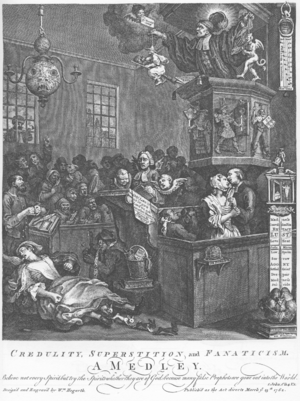- Credulity, Superstition, and Fanaticism
-
Credulity, Superstition, and Fanaticism 
Artist William Hogarth Year 1762 Credulity, Superstition and Fanaticism is a satirical print by English artist William Hogarth. It ridicules secular and religious credulity, and lampoons the exaggerated religious "enthusiasm" (excessive emotion, not keenness) of the Methodist movement. The print was originally engraved in 1759, with the title Enthusiasm Delineated,[1] but never published. The original print may have been a response to three essays published by Joshua Reynolds in The Idler in 1759, praising the sublime work of Italian Counter-Reformation artists.[2] Hogarth reworked the engraving before publishing it on 15 March 1762 as Credulity, Superstition and Fanaticism: A Medley. It echoes his earlier print, The Sleeping Congregation of 1736, in which an Anglican clergyman's boring sermon puts his congregation to sleep.
The print depicts a preacher - possibly George Whitefield[1][3] - speaking to a church congregation from the top of a high pulpit. His text is opened at a page which reads "I speak as a fool", and he is wearing a Harlequin jacket under his clerical gown. He is holding a puppet of a devil with a gridiron in his left hand and a puppet of a witch suckling an incubus in his right hand.[4] His wig is falling off to reveal a Jesuit's tonsure underneath. To the right, the "scale of vociferation" measures his oratory, rising from "natural tone" to "bull roar". (In Enthusiasm Delineated, the puppet of the witch was an abstract figure representing God, and the sides of the pulpit are adorned with additional pairs of religious puppets which are omitted in its final version.)
The print includes visual references to more than a dozen reputed instances of witchcraft or possession in England.[5][6] The three figures decorating the pulpit each hold a candle, and allude to the ghost seen by Sir George Villiers (whose name appears in a book held by the figure on the right), the ghost of the stabbed Julius Caesar appearing before Brutus, and the ghost of Mrs Veale (immortalized by Daniel Defoe in A True Relation of the Apparition of One Mrs. Veal the Next Day after her Death to One Mrs. Bargrave at Canterbury the 8th of September, 1705).[1][7]
In a box pew at the foot of the pulpit, another clergyman pushes an icon of the Cock Lane ghost down the shirt of a young lady in the throes of religious ecstasy. (In Enthusiasm Delineated, this was an aristocratic rake fondling the breast of a woman.) The "Poors Box" has grown cobwebs, showing Hogarth's view that the Methodists were disregarding good works by emphasizing faith so strongly.[7]. To the right, standing on copies of John Westley's Sermons, and Glanvill's Book of Witches, a religious thermometer measures the emotional states of a brain (or possibly a heart) from a central reading of lukewarm, either upwards through love heat, to lust, ecstasy, madness and raving, or downwards through low spirits to sorrow, agony, settled grief to despair, then madness and suicide. On top of the thermometer is an image of the Cock Lane ghost, and the Drummer of Tedworth.
The congregation are in various states of ecstasy, grief and horror. Another minister sings, accompanied by weeping cherubs. A shoe-black vomits nails and pins - possible a reference to the boy of Bilson, who ate metal items. A Jew with a knife sacrifices an insect on the altar. A turbaned Turk looks in at the window, quietly smoking a pipe, and thanks the prophet that he is a Muslim.[8] He represents the "rational, enlightened part of mankind looking down on Christian fanatics with surprise and disgust."[1]
Above the congregation is suspended a "A New and Correct Globe of Hell by Romaine" (possibly referring to William Romaine[1]), with parts labelled "Molten Lead Lake", "Pitch & Tar Rivers", "Horrid Zone", "The Brimstone Ocean", and "Eternal Damnation Gulf". One man below the globe is terrified when a preacher next to him, possibly John Wesley,[1] points it out to him.
Beneath the engraving Hogarth quotes 1 John 4:1, "Believe not every Spirit, but try the Spirits whether they are of God: because many false Prophets are gone out into the World."
Horace Walpole stated that this print "surpassed all his other performances" and "would alone immortalize his unequalled talents."[9]
References
- ^ a b c d e f Krysmanski, Bernd (1998), "We See a Ghost: Hogarth's Satire on Methodists and Connoiseurs", Art Bulletin (80)
- ^ http://www.apocalypsepress.co.uk/other/hogarth/credulity.htm
- ^ Imperial island: a history of Britain and its empire, 1660-1837, Paul Kléber Monod, Wiley-Blackwell, 2009, ISBN 1405134453, p.188
- ^ Artoftheprint.com
- ^ Anecdote biography, John Timbs, R. Bentley, 1860, p.66
- ^ Witchcraft in Europe, 400-1700: a documentary history, Alan Charles Kors, Edward Peters; University of Pennsylvania Press, 2001, ISBN 0812217519, p.388
- ^ a b Black, Joseph (2010). The Broadview Anthology of English Literature: Vol 3 The Restoration and the Eighteenth Century. Canada: Broadview Press. pp. 137–138. ISBN 1-55111-611-1.
- ^ Anecdotes of William Hogarth: written by himself, William Hogarth; J.B. Nichols and son, 1833, p.262-264
- ^ Memoirs of the reign of King George the Third, Volume 1, Horace Walpole, Lea & Blanchard, 1845
Categories:- William Hogarth paintings and prints
- 1762 works
Wikimedia Foundation. 2010.
